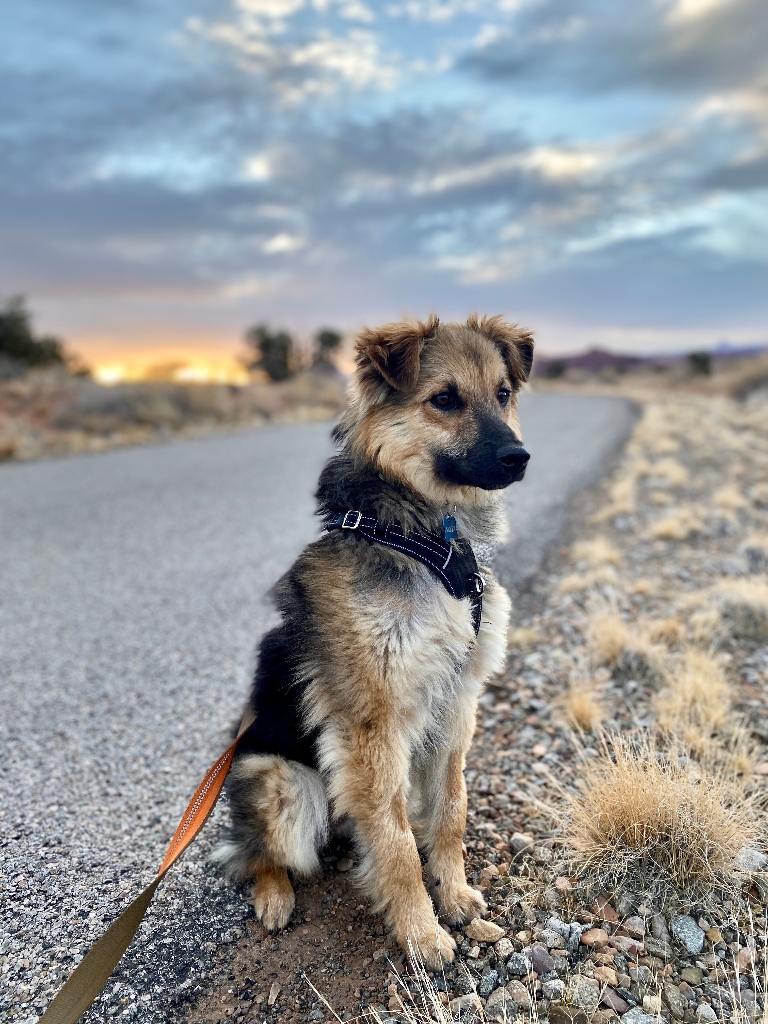
Pets and owners have a special bond, but a national park is not always the best place for pets. Canyonlands National Park is a designated natural area, and its purpose is to preserve and protect the park's natural environment, cultural resources, wildlife, and scenic beauty.
Pets are not allowed:
-
on any hiking trails, or anywhere off-trail, even while in a carrier
-
at any overlooks
-
in the visitor center or any building
-
in the backcountry (including vehicles on backcountry roads, and on any river trips)
Where Can I Take my Pet?
Leashed pets may accompany you in the following areas:
-
Along established front-country roads or in parking areas
- In established front-country campgrounds and picnic areas
Pets may be transported inside vehicles driving the Shafer Trail to Potash Road at Island in the Sky. When the road to Beef Basin via Cathedral Butte is closed by snow/mud, persons with pets are allowed to cross the Needles district via the Elephant Hill-Devil’s Lane/Bobby’s Hole roads. Pets must be on a leash at all times when not in the vehicle, and must remain on the designated road surface only. Any pet excrement deposited on the ground must be collected and removed from the park.
Pet Regulations
-
Pets must be leashed at all times.
-
Leashes must be 6 feet (1.8 meters) long or less.
-
Pets may not make excessive noise that impacts visitors or wildlife.
-
Pet excrement must be immediately collected by the pet handler and disposed of in the nearest trash receptacle.
-
Leaving a pet unattended and tied to an object (other than your own parked vehicle) is prohibited. If leaving a pet unattended, ensure the following:
-
The pet is secured at a location where it will not interfere with wildlife or normal travel by other visitors, and
-
The pet is not being left unattended overnight, and
-
The pet is secured such that no resource damage occurs.
-
-
Pets may not be led by a leash from a bicycle or vehicle.
-
Pets may not be left unattended in vehicles if it creates a danger to the animal or if the animal becomes a public nuisance. Cars heat up quickly. When air temperatures exceed 65°F/18°C, a pet in a vehicle may die—even with the windows cracked.
Pet Safety
Temperatures in Canyonlands regularly exceed 100°F. Extreme temperatures mean pets are susceptible to heat related illness or injury. Look for signs of upset stomach, vomiting, diarrhea, heavy panting, or disorientation and confusion. Rest in the shade, give pets cool water or ice cubes, cool them with a wet towel or with water, and seek medical attention if necessary. Avoid walking pets during the hottest parts of the day.
When walking leashed pets in designated frontcountry areas, keep in mind that pavement can get dangerously hot. Try this test. Place your hand on the pavement for 7-10 seconds. If it is too hot for you, it is too hot for your dog's paws.
| Pavement and Paw Safety | ||||
| When the air is: | 77°F | 86°F | 87°F | 102°F |
| 25°C | 30°C | 31°C | 39°C | |
| The asphalt is: | 125°F | 135°F | 143°F | 167°F |
| 52°C | 57°C | 62°C | 75°C | |
| 125°F / 52°C surfaces will burn skin in 60 seconds | ||||
Why Can't I Have my Dog on Trails?
-
The mere presence of pets alters the natural behavior of wildlife, which can have devastating consequences. Dogs are predators that can chase, scare and transmit diseases to local wildlife. Even their lingering scent can disrupt an animals’ natural movement and behavior. In such a harsh desert environment, expending energy in this way threatens the survival of species that the park aims to protect.
-
Pets can disturb or destroy natural resources, such as native plants and fragile desert soils. Sensitive cultural and archeological sites may be inadvertently damaged by inquisitive pets.
-
The safety of your pet should be a top priority. Canyonlands is a harsh desert environment with many hazards, including sharp rocks, cliff edges, rattlesnakes and scorpions that can harm your pet. Dogs can easily become the hunted. Your pet may become prey for wildlife like coyotes and mountain lions.
-
Not all visitors are comfortable around pets. Dogs can bite humans. Even if your pet follows instructions and is well behaved, others do not know this and may feel uneasy when encountering you. Park visitors should be able to enjoy the park without the disruptions caused by others’ pets.
Service Animals and Emotional Support Animals
Service animals that have been individually trained to perform specific task(s) for the benefit of an individual with a disability are allowed in the park. The tasks performed by the animal must be directly related to the person’s disability.
Therapy, companion, or comfort animals are not service animals under the Americans with Disabilities Act and may not access visitor centers, trails or other non-motorized areas. Owners of service dogs or horses must comply with pet waste and restraint regulations, unless restraint specifically interferes with the task the animal is trained to perform.
Pet owners violating park regulations may be cited, fined, and/or issued a mandatory appearance before the United States Magistrate Court.
Pet Friendly Alternatives Outside of Canyonlands National Park
If you'd like to hike on trails with your pets, there are many options outside Canyonlands National Park, including:
- Dead Horse Point State Park
- Bureau of Land Management
- La Sal National Forest
- Other options for pet-friendly hikes in the area
- Visit discovermoab.com for a listing of nearby kennels, veterinarians, and other pet services.
Is there something we missed for this itinerary?
Itineraries across USA


















































